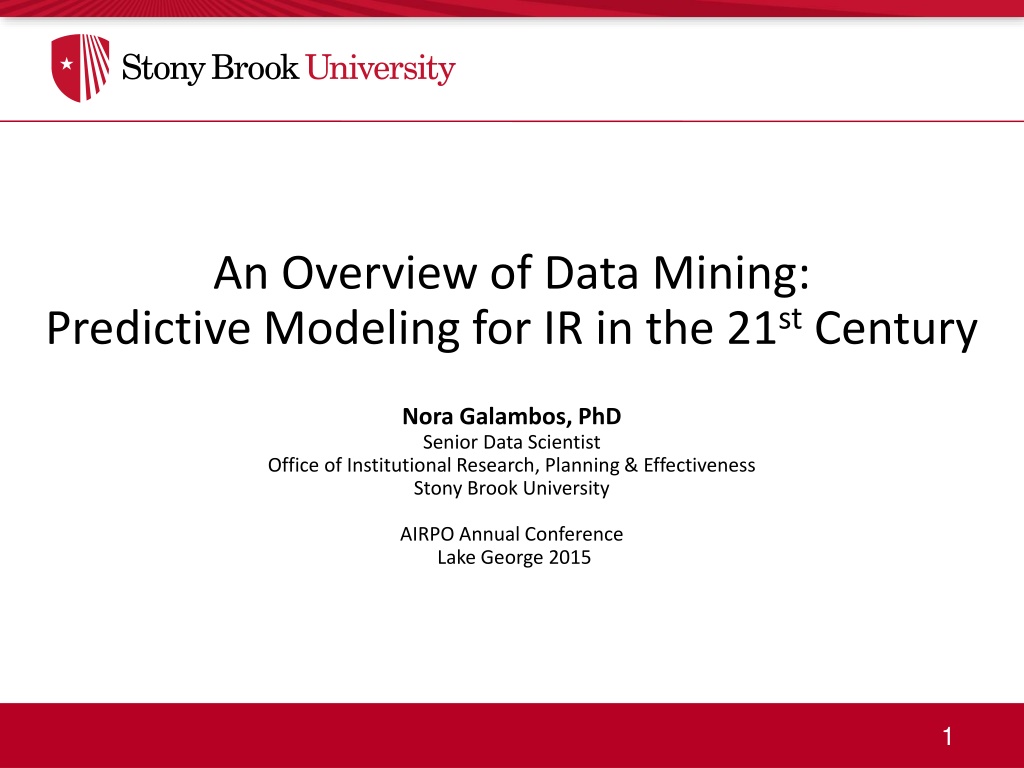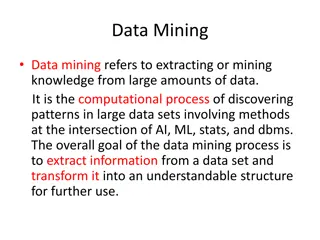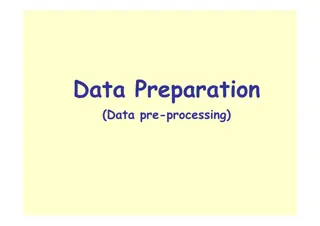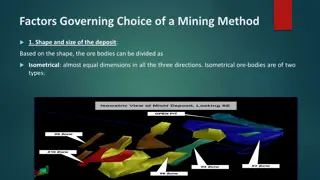Data Mining: Overview and Best Practices for Predictive Modeling
Data mining involves utilizing various methods to analyze and extract valuable insights from a vast amount of data. This process includes data wrangling to prepare the data for analysis, examining missing data, studying distributions, and identifying outliers. Training, validation, and test partitions are crucial for developing accurate predictive models by avoiding under-fitting or over-fitting. Understanding the complexities of the data and selecting appropriate analysis methods are key steps in effective data mining.
Download Presentation

Please find below an Image/Link to download the presentation.
The content on the website is provided AS IS for your information and personal use only. It may not be sold, licensed, or shared on other websites without obtaining consent from the author. Download presentation by click this link. If you encounter any issues during the download, it is possible that the publisher has removed the file from their server.
E N D
Presentation Transcript
An Overview of Data Mining: Predictive Modeling for IR in the 21st Century Nora Galambos, PhD Senior Data Scientist Office of Institutional Research, Planning & Effectiveness Stony Brook University AIRPO Annual Conference Lake George 2015 1
Data Mining Data mining: overview The beginnings of what we now think of data mining had roots in machine learning as far back as the 1960s. In 1989 the Association of Computing Machinery Knowledge Discovery in Databases conferences began informally. Starting in 1995 the international conferences were held formally. Features of data mining Few assumptions to satisfy relative to traditional hypothesis driven methods A variety of different methods for different types of data and predictive needs Able to handle a great volume of data with hundreds of predictors 2
Data Wrangling According to a NY Times article, data scientists spend 50 to 80 percent of their time collecting and preparing unruly data, before it can be explored for useful nuggets. 1 Although CART and CHAID, for example, are able to incorporate missing data without listwise deletion, it still remains important to examine the data and be cognizant of the missing data mechanisms. There is a wide variety of formats for data, and it takes time and effort to configure data from numerous sources so it can be combined. Companies are starting up to provide data cleaning and configuring services. 1Lohr, Steve. The New York Times, August 17, 2014 3
Data Mining: Initial Steps Some of the initial steps are the similar to traditional data analysis. Study the problem and select the appropriate analysis method. Study the data and examine for missingness. Though there are data mining methods that are capable of including missing values in the results rather than listwise deleting the observations, one must still examine the data to understand the missing data mechanisms. Study distributions of the continuous variables. Examine for outliers. Recode and combine groups of categorical variables. 4
Data Mining: Training, Validation, and Test Partitions The purpose of the analysis is both explanatory and predictive. Need to find the correct level of model complexity. A model that is not complex enough may lack the flexibility to represent the data, under-fitting. When the model is too complex it can be influenced by random noise, over-fitting. For example, if there are outliers, an overly complex model will be fit to them. Then when the model is run on new data, it may be a poor fit. 5
Data Mining: Training, Validation, and Test Partitions Partitioning is used to avoid over- or under-fitting. Divide the data into three parts: training, validation, and testing. The training partition is used to build the model. The validation partition is set aside and is used to test the accuracy and fine tune the model. The prediction error is calculated using the validation data. An increase in the error in the validation set may be caused by over-fitting. The model may need modification. The test partition is used for evaluating how the model will work on new data. 6
CART: Classification and Regression Trees Developed by statisticians at Stanford and Berkley in 1984, but was not used widely until after the turn of the century with the expanded use of data mining. Able to handle missing values: does not listwise delete them. Easier to use and often more accurate than logistic regression or other parametric methods. Data transformations, such as those that are sometimes needed for linear regression to satisfy the assumptions, are unnecessary. 7
CART: Classification and Regression Trees Performs binary splits of the measures in the data. CART handles both categorical and continuous measures. The MSE is used to determine the best split for regression trees and a measure of the smallest impurity, such as the Gini Index, for categorical data. The CART algorithm is robust to outliers, which sometimes are isolated in single nodes. When the variable is categorical, classification trees are used, and regression trees are used for continuous variables. For categorical variables, indicator, ordinal, and non-ordinal data can be used. 8
CART: Algorithm Creates a set of decision rules to predict an outcome. Splits categorical predictors into a smaller number of groups or finds the optimal split in numerical measures. Uses recursive partitioning to determine splits with the greatest purity, i.e., the greatest number of correct values in each split. Recursive Partitioning Start with a dependent variable, e.g., did the student graduate? All variables will be searched at every value to find the optimal split into two parts. The search continues to find the optimal split in the new region, continuing until all values have been exhausted. 9
CART: Finding the Tree Size When the tree grows to use all of the variables, which may be hundreds of levels for large complex datasets, the result may not be useful for making predictions with new data. Over-fitting will result in poor predictions when the decision rules are used on new data. The error rate will increase in the validation data. The CHAID algorithm will halt when statistically significant splits are no longer found in the data. There are pruning algorithms to find the optimal tree size. Select a minimum number of observations in a node The complexity of the tree is balanced with the impurity. (The overall impurity is measured as the sum of terminal node classification errors.) Limit the total number of nodes. 10
CART: Missing Value Handling Income is a common survey item that is used to illustrate the handling of missing data. The tails of the distribution may be biased because high and low income people are more likely to not report their income. Problem: Need to separate the low income missing from the high income missing. Surrogates are used to fill in the decisions for missing observations. CART mathematically finds predictors (and ranks them by strength of association, if any exist) that match the decision split of the primary splitter. In that way missing values can be split into both sides of a decision. The output contains the percentage reduction in error for using each surrogate. 11
CART: Classification and Regression Trees Hypothetical Example The xi represent i independent predictors and decision rules for the outcome. Rules for Hypothetical Outcome = 1 xSATCombined SAT <= 1190 xHS GPAHS GPA < 87.0 x3Decision rule for factor 3 x4Decision rule for factor 4 12
CHAID CHAID is another type of tree-based analysis and stands for chi-squared automatic interaction detection. Unlike CART with binary splits evaluated by misclassification measures, the CHAID algorithm uses the chi-square test to determine significant splits, as well as the independent variables with the strongest association with the outcome. It may find multiple splits in continuous variables, and allows splitting of categorical data into more than two categories. As with CART, CHAID allows different predictors for different sides of the binary split. 13
Bagging: Bootstrap Aggregation Method of decreasing the variance of the predictive model. Bootstrap samples are created by sampling the data with replacement. Assuming the original sample has N observations, each mi bootstrap sample has n observations sampled with replacement. The statistic of interest is computed for each sample. For example, we may calculate the mean for each sample. The result will be a distribution of means allowing for a determination of the value of the mean. In bagging, multiple CART models are created using bootstrap samples and the results are combined to reduce the variance of the prediction. For regression the results are averaged. For classification, voting algorithms are used whereby the final classification is the one most frequently predicted by the sample results. 14
CART: Boosting Two computer scientists, Yoav Freund and Robert Schapire, from AT&T Labs developed boosting in 1997 One common boosting algorithm is AdaBoost or Adaptive Boosting, which adds weights to observations to improve the error rate of predictors that do not perform much better than guessing. It will only work for analyses having a binary response variable. Boosting is an iterative procedure with the weights updated at each iteration to the predictions to improve weak predictors. 15
CART: Boosting--Comments A disadvantage is that the result is a weighted sum of trees, which can be difficult to interpret. Since some higher education data, such as SAT scores, may be difficult to split into a binary decision to predict retention or graduation, boosting may improve the model. There is often not a clear cut SAT score value, below which there is an extremely low misclassification of students predicted to leave a university. High and low SAT score students may leave their institutions for very different reasons. Boosting may be able to lower the misclassification rate in such situations. 16
What is a Neural Network? 1 A neural network has a natural propensity for storing experiential knowledge and making it available for use. It resembles the brain in two respects: 1. Knowledge is acquired by the network through a learning process. 2. Interneuron connection strengths known as synaptic weights are used to store the knowledge. Neural networks are especially useful for prediction problems where: No mathematical formula is known that relates inputs to outputs. Prediction is more important than explanation. There is a lot of training data. 1Haykin, S. (1994), Neural Networks: A Comprehensive Foundation, NY: Macmillan ftp://ftp.sas.com/pub/neural/FAQ.html#A2 SAS Enterprise Miner Manual 17
What is a Neural Network? Developed by researchers to mimic the neurophysiology of the human brain. By combining many simple computing elements (neurons or units) into a highly interconnected system, these researchers hoped to produce complex phenomena such as intelligence. In recent years, neural network researchers have incorporated methods from statistics and numerical analysis into their networks. The feedforward neural networks are a class of flexible nonlinear regression, discriminant, and data reduction models, which detect complex nonlinear relationships in data. SAS Enterprise Miner Manual 18
Neural Network Prediction Formula ? = ?00 + ?01 ?1 + ?02 ?2 + ?03 ?3 ?1 = tanh( ?10 + ?11?1 + ?12?2 ) ?2 = tanh( ?20 + ?21?1 + ?22?2 ) ?3 = tanh( ?30 + ?31?1 + ?32?2 ) ?1 ?1 ?2 Y ?2 ?3 19
Use of Transaction Data Goal: Assemble various sources of transaction data to add to the more traditional metrics to measure the interaction of students with their college environment. Some sources to explore: Interactions with the Blackboard course management system login info only; no actual course information Academic advising visits Food service card swipes Interest in knowing what students remain on campus during the weekend Library use 20
Using SAS Enterprise Miner for Predictive Modeling The model presented is a preliminary version for the prediction of the first semester GPA of first-time full-time fall 2014 freshmen. Measures included in the model The results incorporate transactional data to provide different insights into student outcomes. Those data include: Blackboard logins Advising visits Tutoring center usage The model also includes traditional demographics and pre-college characteristics, e.g., SAT scores, gender, ethnicity, and transfer and AP credits upon admissions Financial aid measures: AGI, EFC, and disbursed amounts of different aid types DFW rates Average SAT scores of the students high schools. Preliminary results demonstrate that high school GPA is the strongest predictor and that BlackBoard logins as a proxy for student academic engagement appears to play a more important role than SAT scores. Unfortunately, BlackBoard logins are regularly purged, so using the results of previous cohorts to improve the model is not possible. 21
Variable Importance List: SAS Enterprise Miner Output from Preliminary Decision Tree Analysis Predictive Measures Relative Importance 1.000 0.682 0.544 0.517 0.490 0.456 0.425 0.419 0.387 0.350 0.349 0.317 0.303 0.290 0.273 0.253 0.244 0.223 0.212 0.211 0.193 0.192 0.183 0.149 0.130 0.124 0.099 0.088 High School GPA Avg. BB* logins per non-STEM courses that use BB Received merit scholarship (y/n) BB non-stem course logins in week one Total units transferred in at time of admission BB non-STEM course logins during weeks 2 to 7 Avg. SAT critical reading score by high school (from College Board data) Math Placement Score BB STEM course logins during weeks 2 to 7 BB non-STEM course logins through week 7 BB STEM logins weeks 1 to 7 Avg. SAT math score by high school (from College Board data) BB avg. logins per STEM course Total AP STEM units DFW STEM rate in first semester courses Number of STEM credits with DFW rates >= 10% Number of non-STEM credits with DFW rates >= 10% Received Perkins loan (y/n) Gender Avg. SAT math and verbal score by high school (from College Board data) Received TAP (y/n) Amount of federal financial aid need Amount of disbursed scholarship aid Combined SAT math and verbal score Advising visits during week 2 to 7 Level of math courses, e.g., MAP, calculus or higher level SAT writing score SAT verbal score *BB = BlackBoard 22
Preliminary Decision Tree Model Predicting First Semester GPA for First-Time Full-Time Freshmen Average First Semester Freshmen GPA Average GPA: 3.12 Count: 2842 HS GPA 92.0 < >= 92.0 Avg GPA: 3.30 Count: 1508 Avg GPA: 2.91 Count: 1334 Avg. BB Logins per Non-STEM Course No Scholarship Avg GPA: 3.14 Count: 700 >=15 Scholarship Avg GPA: 3.44 Count: 808 <15 Avg GPA: 3.06 Count: 805 Avg GPA: 2.66 Count: 529 23
Preliminary Decision Tree Model: First Semester GPA for First-Time Full-Time Freshmen First Level: High School GPA; Second Level: Received Scholarship (Y/N) HS GPA > 92, No Scholarship BB = BlackBoard; DFW refers to courses/credits taken in high DFW rate courses, not the students grades. 24
Preliminary Decision Tree Model: First Semester GPA for First-Time Full-Time Freshmen First Level: High School GPA; Second Level: Received Scholarship (Y/N); Third Level: Entered College with Credits HS GPA > 92, Received Scholarship, Entered College with >= 16 Credits ADV refers to advising visits; hs_avg_satcrm is the average SAT CR and Math Score by high school as reported by The College Board. 25
Preliminary Decision Tree Model: First Semester GPA for First-Time Full-Time Freshmen First Level: High School GPA; Second Level: Avg. BlackBoard Logins per Non-STEM Course; Third Level: BlackBoard Total Non-STEM Logins HS GPA <= 92, Avg. BlackBoard Logins per non-STEM Course <15.1, Total BlackBoard non- STEM Logins < 8.5 26
Predictive Analytics Rankings: The Forrester Wave http://www.forbes.com/sites/louiscolumb us/2015/05/25/roundup-of-analytics-big- data-business-intelligence-forecasts- and-market-estimates-2015/ Forrester Research (Nasdaq: FORR) is an influential research and advisory firm. They work with business and technology leaders to develop customer- obsessed strategies that drive growth. 27
Predictive Analytics Rankings: Gartner Magic Quadrant http://www.forbes.com/sites/louisc olumbus/2015/05/25/roundup-of- analytics-big-data-business- intelligence-forecasts-and-market- estimates-2015/ Positioning Technology Players Within a Specific Market: Gartner, Inc. (NYSE: IT) is a leading information technology research and advisory company. Gartner delivers the technology- related insight for client decision- making. 28
Software Vendors SAS Enterprise Miner http://www.sas.com/en_us/software/analytics/enterprise-miner.html SPSS Modeler http://www-01.ibm.com/software/analytics/spss/products/modeler/index.html Rapid Miner https://rapidminer.com/ Salford Systems https://www.salford-systems.com/ 29





























